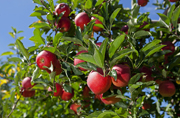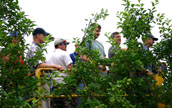
Northern N.Y., September 4, 2018. With the progress of precision orchard management research funded by the farmer-driven Northern New York Agricultural Development Program (NNYADP), regional apple growers are increasingly targeting key production practices to harvest larger, higher quality apples for market. Income per acre is influenced by fruit size and quality.
Three growers in northeastern New York are providing data to help Cornell University horticultural researchers refine computer modeling designed to more precisely apply orchard irrigation and thinning practices.
The on-farm orchard trials at the Northern New York orchards have evaluated water management. The Cornell team estimates that in some seasons a lack of irrigation can lead to small fruit and an economic loss of $3,850 to $6,809 per 2.5 acres of orchard, depending on the density of the trees. Losses can be higher for late-season varieties that require a longer growing season.
A proper water supply that limits or eliminates drought stress on trees is essential to maximum apple size at any given crop load. Growers can improve orchards yields by following computer modeling to precisely irrigate their crop on a weekly basis.
The on-farm trials use computer modeling to guide precisely when growers need to thin tree buds to reach desired crop load.
For each variety of apple, each individual orchard, and each grower, there is an optimum number of fruits per tree to achieve the best yield and desired fruit size and quality to bring the highest economic return.
In recent years, the focus of the regional trials has been on production of the popular Honeycrisp and Gala apples.

More precisely targeting thinning spray applications can reduce orchard costs and can enhance the use of pollinator-friendly treatments.
To encourage fruit size and quality, the modeling also directs pruning by hand to reduce competition among flowers and fruitlets.
The three Northern New York growers participating in the NNYADP-funded research are among 20 farmers contributing to a statewide project developing recommendations for precision orchard management practices. Components of the modeling have been developed at Cornell University and the University of Massachusetts.
The NNYADP provided new funding to continue the research in 2018. The fall harvest data will add more data to help refine modeling accuracy and sensitivity, particularly to extreme weather conditions that can include sudden drops in temperature, extended cold or rainy seasons, hail and other challenges that can damage apple crops.
Funding for the Northern New York Agricultural Development Program is supported by the New York State Senate and administered by the New York State Department of Agriculture and Markets. For more information, see the Horticultural Research section of this website.